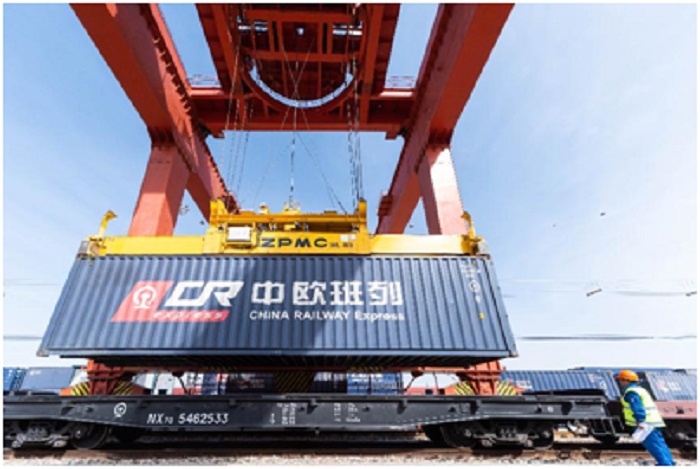



The China-Europe freight train service made its 10,000th trip this year as the train X8015 started its engine and headed for Duisburg, Germany from Wuhan, central China’s Hubei province on the last day of August, carrying auto parts, electronic products, daily necessities and anti-pandemic materials.
Statistics showed that China-Europe freight trains made 10,030 trips in the first eight months this year, sending 964,000 twenty-foot equivalent units (TEUs), up 32 percent and 40 percent, respectively. Loaded containers accounted for 97.9 percent of the total.
“The China-Europe freight train service is on a robust growth,” said the director of the Freight Transport Department of China State Railway Group Co., Ltd. (China Railway).
According to him, China-Europe freight trains have made over 1,000 trips in each of the past 16 months, and the monthly number of trips has been kept above 1,300 since May this year. The service has made positive contributions to stabilizing international industrial and supply chains and promoting the “dual circulation” development pattern.
The 10,000-trip milestone this year arrived two months earlier than that a year before. Behind such performance were optimized management, improved efficiency, and expanded handling capability of ports.
“We have constantly optimized our working procedure, shortened the time of transshipping, improved efficiency, and made good use of digital platforms,” said Gao Qiang, deputy director of the cargo-loading workshop of the train station in the border city of Alashankou, northwest China’s Xinjiang Uygur autonomous region. Over 4,000 China-Europe freight trains have passed the Alashankou port his year, he added.
Since the beginning of 2021, the ports in Alashankou and Khorgos of Xinjiang Uygur autonomous region and Manzhouli of north China’s Inner Mongolia autonomous region have successively launched expansion and upgrading projects, which has significantly improved the handling capacity for China-Europe freight trains.
The west, central and east routes of the China-Europe freight train service witnessed a year-on-year growth of 37 percent, 15 percent and 35 percent, respectively, in the number of trips made by China-Europe freight trains from January to August this year.
Besides, railway authorities also collaborated with port supervisors to facilitate customs clearance and improve customs clearance capability and efficiency, which effectively reduced the time of shipment.
Wang Bo, senior logistics manager with LONGi Green Energy Technology Co., Ltd., the world’s most valuable solar technology company, introduced that the company is now seeing halved transportation time and reduced warehousing cost thanks to a freight route tailored by the railway department specifically for photovoltaic products.
“China-Europe freight trains have significantly counteracted the impacts from COVID-19 for enterprises and become a regular logistics channel for our deliveries to European clients,” Wang said.
Since this year, local railway departments have enhanced communication with foreign trade enterprises to learn their logistics demand, and issued targeted plans of transportation.
Zhengzhou, central China’s Henan province, had its 10th overseas station of the China-Europe freight train service after a train arrived in it from Italy’s Milan this July. In June this year, a new freight route was opened between Wuyishan, southeast China’s Fujian province and Russia’s Moscow, integrating the Chinese tea production center closer into the Belt and Road. Northern China’s Shanxi province also launched its first freight routes to Paris and Turkey’s Mersin this summer, facilitating the transportation of dozens of commodities such as metal products, agricultural produce and electromechanical devices.
So far, the China-Europe freight train service has opened 73 operation routes to some 170 cities in 23 European countries, carrying over 50,000 types of cargos. It has facilitated synergetic production in and outside China, lowered logistics cost for enterprises, and offered support for the economic and social development of the Belt and Road countries.
The China-Europe freight train service is a manifestation of China’s major country responsibility for what it has done to alleviate the COVID-19 pandemic – transporting anti-pandemic materials as soon as possible and as many as possible.
According to the Freight Transport Department of the China Railway, anti-pandemic materials have been taken as a priority by the China-Europe freight train service. Since the pandemic broke out, China-Europe freight trains have transported 12.8 million anti-pandemic items weighing 99,000 metric tons to European countries, making positive contributions to international anti-pandemic cooperation.
“The China-Europe freight train service will still in a high demand as the Chinese economy recovers stably,” said the director of the department.


Cooperation between China and Nigeria had.



Nigerian government has urged trainees of.



Minister of State for Foreign Affairs,.


The Nigerian Government has congratulated the.


The Humanitarian Service Diamond Awards has.
A Chinese Company, Inner Galaxy Steel.


The Programme Coordinator, Regulatory, Compliance and.


A Non-Governmental Organization (NGO), Committee for.
The Trustfund Pensions Limited has chided.


The House of Representatives Committee on.
Leave a Comment